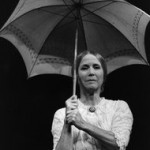New York Times theatre critic Ben Brantley remembers Julie Harris, who died Saturday.
She had a heightened, almost feverish presence that seemed tantalizingly at odds with the naturalism of film. Ms. Harris was unabashedly ardent in a way that most movie stars were not. Her tremulousness suggested she experienced life more intensely than those around her.
This made her ideal for the self-dramatizing heroines she had originated onstage and then recreated on film: the madcap Sally Bowles in “I Am a Camera” and the anguished 12-year-old Frankie of “Wedding,” characters who long to be somehow exceptional; who were, by nature and by faith, theatrical.
I mean it as a compliment when I say that when I watched her in a film, I could imagine her onstage in the theater — for me, as a kid, the more exalted art. And when I finally did see Ms. Harris on a Broadway stage, in “Lucifer’s Child,” a one-woman show about Isak Dinesen, the glow was only brighter, and she seemed larger than she had in cinematic close-up.
As it happened, though, my first experience of Ms. Harris in the flesh was not across the footlights. In my early 20s, at the request of my parents, I introduced myself to her at a party I was covering as a reporter for Women’s Wear Daily. (I was shy, but she was shyer.) She had married that writer friend of my dad’s — his name was Walter Carroll — many years, and several marriages, after they had first known each other.
So that Christmas, Julie and Walter came to visit my parents. There she was, in the house where I grew up, looking and behaving like just another of my parents’ middle-aged friends. I hung back, self-conscious and a bit disappointed, leaving the older folks to their conversation. It may have been around that time that I decided it was best to keep your distance from people you had turned into deities.
It would be another 20 years before I would have my second personal encounter with Ms. Harris. By then, I had become a theater critic for The New York Times, and she was appearing in a revival of “The Gin Game” on Broadway. Though Ms. Harris’s marriage to Mr. Carroll had ended, she and my mother remained friendly. In one letter to my mother, Ms. Harris noted how pleased and surprised she was that I had mentioned her in describing the incandescence of another actress.
I was stunned that she would be surprised. How could she not have known how much of a reference point she would be for me and so many other theatergoers, a standard to which we inevitably compared others?



“The Belle of Amherst” in Detroit, l-o-n-g ago. My neighbor next door remembers her from “The Member of the Wedding” even longer ago. Through the years she has popped up in our chats like mentioning a relative, which in the way of art she was.